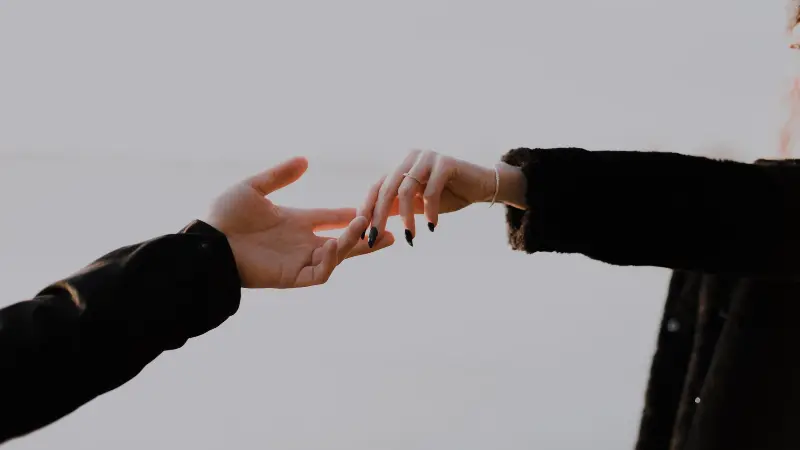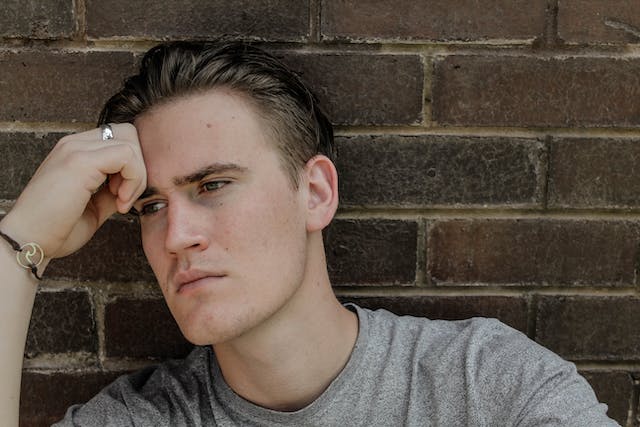Happiness
Happy Again: How To Find Beauty in the Everyday (Encore)

DACHER KELTNER Hi, I’m Dacher Keltner and this is The Science of Happiness. This week we’re replaying a favorite episode of mine, where we’re joined by Stacy Bare, an Iraq War veteran who discovers he can find moments of awe and beauty in unlikely places. We’ll be back with an all-new episode in two weeks.
STACY BARE I was in Boulder, Colorado. I was working for Veterans Green Jobs. I was just struggling. I didn’t know where I was. I didn’t have a sense of who I was, or my place in the world. And I felt like I was creating an unnecessary burden on people in the world. And I was feeling horrifically guilty that I was feeling that way. And what am I doing alive when friends of mine who had kids and careers and everything to live for didn’t make it home? And why am I here?
What would I have done if I was a teenager living in Baghdad? What did I do to deserve this life that I had? And was I just wasting it away? So that’s where this idea of annihilation, or ceasing to exist became so powerful. And I kept calling a friend of mine that I’d deployed to Iraq, talking about wanting to join the military, or get out of life completely, join the military or get out of life. And other people might look at that as, you know, death by suicide. But I thought about it as disappearance. And he really was like, look, you gotta do something about it. And he’s like, come rock climbing with me. And we did.
We didn’t go all the way top. We’re moving very slow. And all of a sudden I couldn’t move any further. I was paralyzed with fear. I started sobbing that I was afraid. And I think it was that moment when I realized that without the help of chemicals, alcohol, or drugs, I had realized that for the last several hours I had not been thinking about anything other than the now.
And that’s when all the fear and all the guilt and all the failure or feelings of failure just came rumbling through me. And I was shaking, and crying, and sobbing. And I was thankful to be in the arms of a close and trusted friend who’d been through this before with himself and with other people. And he said, it’s all right. You know, you’re gonna be OK. And this is gonna be OK. And you can do this.
And I think that was the first time in a few years that I believed it is okay. And I am okay. And I can’t get through this.
DACHER KELTNER It is a pleasure and honor to host today on our show, one of my heroes out in the world, Stacy Bare. Stacy is a veteran of the Iraq War, where he served as a captain in the U.S. Army. And today, what he’s really trying to do is to lead an outdoors revolution where we use the power and wisdom and healing properties of nature to teach others how to remedy life’s calamities.
I’ve partnered with Stacy for several years at the Greater Good Science Center, where we started the Great Outdoors Lab, and got veterans and young kids from under-resourced schools out in the wild to really document what nature does to us, and how it benefits us. And that’s just a small part of what Stacy does.
He led outdoors programs at the Sierra Club. In 2014, he was named the National Geographic Adventurer of the Year, one of the Adventurers of the Year. So he’s really a modern hero of the environmentalist movement.
He tried one of the research-backed happiness practices from our greater good in action website designed to increase kindness and connection.
Stacy, thank you for joining us on the Science of Happiness.
STACY BARE Thanks, Dacher. That’s awe-inspiring to hear you say those things about me. I appreciate it.
DACHER KELTNER Yeah. I revere the work that you do. I wanted to ask you what was it like coming back home after the Iraq War? I know you were dealing with symptoms of PTSD.
STACY BARE It was very different than what I thought it would be. You know, coming home was hard. And yeah, one of the hardest things about coming home over the last 12 years is beginning to in some ways move on from my veteran identity as a key defining part of who I am. It will always be part of who I am, but it’s no longer a central element of who I am. And that’s been difficult both for me and for other folks in the veteran community.
And I think for a lot of the country, the only people that are allowed to really grieve are cancer fighters and survivors, military veterans and first responders. And nobody else is nobody else’s pain is worthwhile.
There are people who have tremendous privilege, but that doesn’t mean they don’t also have tremendous pain. And I think we can hold the pain of the privileged and the pain of the underprivileged and the pain of our service members. I don’t think we need to compare those. I think we need to hold those individually and recognize that pain across the board is pain. And what are we doing to mitigate that, and not really mitigate pain, but to build joy?
DACHER KELTNER I feel like a lot of that work you’ve done with Sierra Club and Adventures, Not War, and just using nature to heal. And it began that day you were mountain-climbing in Colorado. What happened on the mountain?
STACY BARE It pulled me into a moment. And I think for the first time I was forced to be deliberate. You know, I kept asking for the rope to take. I kept asking for a tighter rope as I was climbing up. And in a conversation with my friend Priscilla about two months ago, she said, “Well, don’t you think the fact that you kept asking for a tighter rope actually was an indication that you wanted to live?” And I never thought about it that way. But it’s true.
You know, if I really wanted to let it all go, I had several amazing opportunities to do so on that rock, or at least to try. But I held on to my life. And it was a deliberate problem-solving moment where I was not thinking about anything other than the moment. And I had what I now know to be a tremendous somatic experience before I was belaying down. And all the energy and pain and frustration and trauma over the last several years literally shook out of me.
DACHER KELTNER You know, it’s always telling what people choose as a happiness practice. And you chose that Noticing Nature practice. There are upwards of 20 reasons why just getting outdoors is good for your nervous system, your brain, your attention, your relationships. Walk us through the practice. What was it like for you so devoted to the outdoors to do the Noticing Nature Practice. What did you do?
STACY BARE When you’re outside, look around for nature and look around for beautiful moments. And then take the time to stop and take a photo and hold onto that photo for you. And if you can write about it or share it with other people and share with them, you know, maybe what you’re thinking about in that moment or why, that’s beautiful.
DACHER KELTNER You know, we have a lot of practices that focus on nature at Greater Good in Action website that focus on nature, so why did you choose the Noticing Nature practice?
STACY BARE I think that I try to be pretty intentional about how I spend my time outdoors and what I’m doing outdoors. But it was fun to take pictures for a different reason and it was fun to really focus on it. And in some ways, it’s a practice that at various times, I think especially over the last few years, I’ve been a part of: trying to notice awe and trying to notice beautiful moments.
But this time I just allowed myself to really take a look and see what was there. And it was fun because if anything, it was just a real reminder of the world we live in. And I and I get to live in an incredibly beautiful place. But I’ve always lived in beautiful places. Brookings, South Dakota; Oxford, Mississippi; Darmstadt, Germany. Now out in Sandy, Utah. I’ve always had the good fortune of living in beautiful places. And it was nice to think about, “What’s the beauty outside the front door?”
DACHER KELTNER The Noticing Nature practice instructs you to take photos of nature, but when I was looking through your photos I noticed you have a lot of shots of your wife McKenzie and your toddler, Wilder. There’s even a selfie of the three of you!
STACY BARE Yeah. The selfie. It’s kind of awkward. You know, the trees are at a weird angle and we’re trying to figure out how to take it. And Wilder said there’s sunshine in her face, which is clearly not the case because you can see sunrays behind us and the mountains. And my wife is just laughing hysterically at this moment. And, it’s hard for me to separate people from nature. We are part of the environment. This is a selfie of my favorite representatives of the human species out being humans. Because, I’m a big fan of my little family, and I think we’re pretty great humans and we just had everything on that hike. And so just the look on my wife’s face kind of says it all.
DACHER KELTNER Celebrating.
STACY BARE Celebrating!
DACHER KELTNER Can you read us one of your favorite passages associated with that photo?
STACY BARE I had walked ahead of Mackenzie and Wilder there and they’re coming up to Secret Lake. And. Mackenzie’s head’s kind of down. She’s grinding through it. It’s this beautiful mountain in the background and kind of this big long and they almost look like paving stones. But it’s just it’s just the natural trail coming out. And I wrote that, “I never would have done this hike, kid. It was the longest, most grueling 0.8 miles ever. But the reward was sweet while they felt on top of the world in surprise. You could hike this far and this high.” And I think that’s you know, it’s just 0.8 miles from the trailhead. And my wife and I never would’ve been like, “Let’s go do the 0.8 mile trail.” You know, we’re like, “You want to do five miles or 20 miles or what are we going to do?” You know? And it’s like “If it’s over 18 miles, should we backpack or should we just push was 21 miles? We just push through and do this in a day?” And that’s how we used to be. And now here we are like “Point-eight miles, can we do it?
DACHER KELTNER There’s another sweet one of your daughter holding a leaf up to the camera. And our listeners can actually check out the picture, and other photos you took and wrote about, on the Greater Good Science Center’s Facebook and Instagram pages. Was that the same hike? How did the hike go for you guys?
STACY BARE If I’m honest, it was maddening. I mean, she was you know, I want to be like, “You’re so damn slow and I know you can go faster!” And, “Why are you looking at that leaf?” And but then you’re like, “All right well, why don’t I turn this around and use this as my practicing nature and try and find something beautiful, and try and see what she’s seeing. And that transforms the journey into a more meditative experience and much more mindful experience. And then, I mean, she’s enraptured almost the entire time. Until she gets tired.
So, it was just it was a good reminder of some of the physical, I mean, you almost really have to like reach into your mind, and there’s some switch in there where you just have to grind it down to a little bit slower, more patient experience. And you notice awe in a lot more places and it’s not more of like I’ve got to go from point A to point B and at point B, I’ll find the awe and then I have to struggle to get over to point C. But it really does allow for the journey to be the destination. And that’s a constant reminder, I think living with a toddler, that the destination is the journey. And we were lucky we made it all the way to this amazing waterfall. But then McKenzie and I thought that waterfall was so cool. And Wilder found this really cool leaf right there. And she looked at the waterfall for all of two seconds and then wanted us all to spend a few minutes staring at this crazy leaf, and my partner is good at making sure that I give in to those moments.
DACHER KELTNER Were there any moments where the beauty and awe caught you by surprise? Like, “Wow I never noticed this thing in nature could be so beautiful.”
STACY BARE For me, what it really caught me on was like, for example, I was in L.A. for work doing this and I’m like, “I’m gonna have to drive up into the city.” And as I’m driving up into the city, and it’s like 5:30, and there’s traffic everywhere. And all of a sudden I turn down this one huge road and there’s no cars on the road at all. It’s like it’s like the Red Sea is parted, and it’s just these beautiful palm trees everywhere. And I just, pulled over and stopped and took the picture. And I was like, wow, like everywhere. I mean, it’s just there these opportunities just everywhere to find beauty, and it’s just a reminder, you know, we are part of nature. We feel this need to create such ad instinct barrier between nature and man-made, and I think that’s part of the problem.
And, you know, yesterday I was you know, there’s this shortcut that I take through town on my bike and it’s like a cool little gravel road. And I didn’t have to deal with traffic, and it’s on this canal. But there’s a ton of nature right on this canal. The practice, forced me to stop and think about that and force me to stop and see what was there.
DACHER KELTNER You did this practice for each day for a couple of weeks and…
STACY BARE Yep.
DACHER KELTNER I mean, this is your life, your life’s work, right? Getting people to notice the outdoors and what did you notice emotionally for yourself as you had these experiences? What struck you?
STACY BARE I think it struck me how often, even though, intellectually, and I’ve said this and talks and written before, intellectually, I talk about how nature can be everywhere and you need to find it and look for it everywhere. But to do that really does require practice. And that, happiness is a skill as much as it is something that just happens to you.
We can refine, you know, there’s a balance of when you go looking for awe, versus when you find awe. And it was a good reminder that oftentimes awe and happiness come in the least planned situations. It’s like when you expect awe from climbing a mountain, you may or may not get it. And sometimes even hiking with my daughter. I’m like, it’s great to be outside, but I wish I was doing X right. I wish I was going to the top of that peak or whatever. And it was like, no. Slow down. Realize where you are. Realize how fortunate you are to have this time in this space and this energy and see it and actually take a look.
This practice, doing that practice of daily nature was just good work around mindfulness, and the reminder that you don’t have to do these big, huge adventures to find nature and to find awe and to find healing.
And, you know, I think one of the really important things about time outside is, the research and the science we’ve done together, we’ve been able to show, you know, the reverse inflammation effect and, you know, the physiological changes that happen in your body when you experience awe. And the thing that I’m consistently most excited about, though, is, those are amazing things and those are really helpful. And I think we’ll be able to show in time that those are as effective for most people as current SSIDs and other medication that are out there for the physical changes. But the thing I get most excited about is this openness after a moment of awe, new ideas and curiosity that you have.
DACHER KELTNER Stacy, one of the things that you’ve done, you know, you take poor kids in schools and we know they’re suffering from elevated cortisol, problematic inflammation. And you take veterans and all the issues they’re facing, you get them out on these wild trips. How would you think about building in this kind of simpler exercise of just noticing nature into your work?
STACY BARE Yeah I think it’s the critical step that we need to take, right, to prepare people for large expeditions and to help people stay in awe and stay in nature. And I think it’s just the momentum we need.
It’s like if you don’t want to go running, put on your running shoes anyway, because once you put your running shoes on, you’re like, well, I might as well go outside and then you’re outside like, well, maybe I will go for a walk and then you start walking. And then you’re like, maybe I’ll go for a little jog. Next thing you know, you’re running. And I think it’s the same thing with Noticing Nature is that, you know.
In my head, I’m thinking about these big sweeping vistas and mountains that I want to ski and and all these things. But. What this really did was force me to recognize how beautiful the world is everywhere we go, even if it’s just driving down a four lane road in the middle of Los Angeles, right. Like find a beauty, see the beauty.
It strips us away to our basic humanity. And that’s what’s driven a lot of my work is wanting people to feel human and how good that can be.
DACHER KELTNER Well, Stacy, I I wanted to thank you for doing the practice and I wanted to thank you for all the work you’re doing for kids and veterans and our broader culture about getting outdoors, and really capitalizing on the benefits of awe. Thanks for being on the show.
STACY BARE Thanks for having me on.
DACHER KELTNER There is quite a bit of research on the benefits of exposure to nature. Even a brief, 15-minute walk, or looking at photos of nature that somebody else took, or watching a nature video, makes our bodies and minds healthier afterwards.
HOLLI-ANNE PASSMORE People who spend time in natural environments have higher levels of all kinds of different positive emotions. Essentially, they are happier.
DACHER KELTNER More on the science behind the Noticing Nature practice, coming right up.
You don’t have to be a nature-lover like Stacy to reap the benefits of the Noticing Nature practice. Research shows it can actually be good for people who don’t feel a oneness or kinship with the environment. What we know is that exposure to nature can reduce blood pressure, muscle tension and stress hormones. Studies show it can also make you feel more creative and alive.
Dr. Holli-Anne Passmore is the director of the Nature of Meaning and Life Research Lab at the University of British Columbia. She wanted to see what would happen if people noticed and reflected on nature in their day to day lives.
HOLLI-ANNE PASSMORE What I had people do, was simply pay attention to how the nature that you notice just in your everyday routine, notice how that nature makes you feel. And then people have either taken a photo of it, or even just writing it down as well.
DACHER KELTNER Participants uploaded the ten photos they took over the two week experiment period and then they sent them to Holli-Anne.
HOLLI-ANNE PASSMORE And then they also uploaded a description of, “Here’s what I felt when I saw this particular scene.”
DACHER KELTNER The second group was instructed to pay attention to how man-made objects around them made them feel.
HOLLI-ANNE PASSMORE And then a third group was simply a business as usual. So essentially, they’re just doing nothing.
DACHER KELTNER After two weeks, people in the Noticing Nature condition reported more feelings of awe, inspiration, and transcendence.
HOLLI-ANNE PASSMORE They had greater life satisfaction. They felt not just connected to nature, but connected to other people, connected to life in general.
DACHER KELTNER Nothing changed for the people in the other two groups, the ones that just focused on man-made objects, or went about their daily lives as usual.
HOLLI-ANNE PASSMORE We’re not talking about people when and oh, I went backpacking for the weekend or so. So some of these people could go sit by a lake. But the vast majority of photos that people uploaded or the written descriptions of nature were quite seriously, “I saw, when I was waiting for the bus stop. There’s a really beautiful tree there.”
DACHER KELTNER In follow-up studies, Holli-Anne didn’t have people take pictures. They were just instructed to notice nature, and then write down a description of what they saw, and how it made them feel.
HOLLI-ANNE PASSMORE Based on the analysis, It doesn’t really seem to make a difference. It really is the action of simply paying attention to the nature: The tree at the bus stop, the bird chirping, the grass, the flowers that are growing, and the fall leaves the plant in your in your room — paying attention to those and really noticing how those make you feel.
DACHER KELTNER Next time, on The Science of Happiness. Former US surgeon general Vivek Murthy on breaking out of loneliness—and the science of forging deeper connections.
VIVEK MURTHY My experience of loneliness really began in childhood, when as a student in elementary school, I had this sense of dread. I didn’t want to be alone, once again, on the playground, and I certainly dreaded walking into the cafeteria each day, not knowing if there would be somebody to sit next to. And that stayed with me for many, many years.
DACHER KELTNER I’m Dacher Keltner, thanks for joining me on The Science of Happiness.
Our podcast is a co-production of UC Berkeley’s Greater Good Science Center and PRX. Our senior producer is Shuka Kalantari. Production assistance is from Jennie Cataldo and Ben Manilla of BMP Audio. Our associate producers for this episode are Haley Gray and Annie Berman.
Our executive producer is Jane Park. Our editor-in-chief is Jason Marsh. Our Science Director is Emiliana Simon-Thomas.
We’ve got a new book out now on the science of gratitude, featuring many of our past guests like comedian W. Kamau Bell and psychologist Sara Algoe. Learn more at greatergood.berkeley.edu/gratitudeproject
You can try out the Noticing Nature practice by visiting ggreatergood.berkeley.edu/podcasts, and clicking on this episode.





